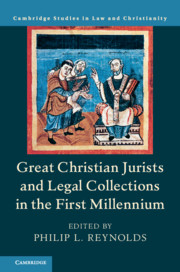Book contents
- Great Christian Jurists and Legal Collections in the First Millennium
- Law and Christianity
- Great Christian Jurists and Legal Collections in the First Millennium
- Copyright page
- Contents
- Contributors
- Preface and Acknowledgments
- Abbreviations
- Part I
- 1 Normative Texts and Practices of the First Millennium
- 2 The Many Voices of Roman Law
- 3 The Law of the Post-Roman Kingdoms
- 4 Ecclesiastical Councils
- 5 The Papacy
- 6 The Sacred Palace, Public Penance, and the Carolingian Polity1
- 7 Canonical Collections
- 8 The Practice and Literature of Penance
- 9 Monastic Rules
- Part II
- Index
- References
8 - The Practice and Literature of Penance
from Part I
Published online by Cambridge University Press: 21 June 2019
- Great Christian Jurists and Legal Collections in the First Millennium
- Law and Christianity
- Great Christian Jurists and Legal Collections in the First Millennium
- Copyright page
- Contents
- Contributors
- Preface and Acknowledgments
- Abbreviations
- Part I
- 1 Normative Texts and Practices of the First Millennium
- 2 The Many Voices of Roman Law
- 3 The Law of the Post-Roman Kingdoms
- 4 Ecclesiastical Councils
- 5 The Papacy
- 6 The Sacred Palace, Public Penance, and the Carolingian Polity1
- 7 Canonical Collections
- 8 The Practice and Literature of Penance
- 9 Monastic Rules
- Part II
- Index
- References
Summary
This chapter discusses the formal and less formal ways in which Christians in the first millennium, especially during the early Middle Ages, could compensate for transgressing moral rules. Monastic ways of confessing and atoning for transgressions were introduced to specific lay audiences. Especially in the insular world, penitential books were composed that provided guidelines for this process. Such works were closely connected to other forms of ecclesiastical regulation. In the Carolingian world, penance became an issue of central concern, discussed at councils and in canonical collections. As a consequence, a substantial number of new texts were composed and disseminated widely. Such works of Carolingian inspiration reached an audience outside of the Carolingian realms: in Spain, Italy, and England. They were also increasingly included in canonical collections. The close connection between penitential books and canonical collections suggests that both genres could be employed in diverse settings. Distinctions between public and private penance, or between penance and jurisdiction (judicial punishment) are not as clear or self-evident as used to be thought.
Keywords
- Type
- Chapter
- Information
- Publisher: Cambridge University PressPrint publication year: 2019



